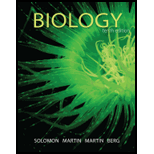
The mechanism that leads directly to morphogenesis is (a) differential gene expression (b) pattern formation (c) nuclear equivalence (d) cell differentiation (e) cell determination
Introduction: Many processes are involved in shaping the microorganism and its structures so that it performs the correct functions and with the greatest efficiency. An organism gains its form from an undifferentiated mass of cells to gain the function and characteristics that are specific to it. These processes are cell determination, cell differentiation, pattern formation, and morphogenesis.
Answer to Problem 1TYU
Correct answer: The mechanism that leads directly to morphogenesis is pattern formation. Hence, the correct answer is option (b).
Explanation of Solution
Reason for the correct answer:
Over many steps, an intricate pattern is created by the tissues to form organs, shapes, and structures of the organism and this is called pattern formation. It is driven by chemical signals. The process of morphogenesis proceeds by the process of pattern formation. Morphogenesis refers to the process of organizing the structures of the cell by forming it into shapes and structures that help to facilitate the function of the cells so that they perform their specific functions. Hence, pattern formation leads directly to morphogenesis.
Option (b) is given as “pattern formation”.
Pattern formation is caused due to morphogenesis. Hence, the correct answer is option (b).
Reasons for incorrect answers:
Option (a) is given as, “differential gene expression”.
Differential gene expression refers to the process by which cells express certain portions of their genes to perform specific functions. It occurs while the embryo is forming on the undifferentiated mass of cells and not during the development process. Hence, option (a) is incorrect.
Option (c) is given as, “nuclear equivalence”.
Nuclear equivalence is the principle that the nuclear content of cells remains conserved during the development of the embryo. It does not have any role in pattern formation or morphogenesis. Hence, option (c) is incorrect.
Option (d) is given as, “cell differentiation”.
Cell differentiation is the process by which a cell gets specialized to perform a particular function. It does have a role in the development of the organism but does not directly cause the process of morphogenesis or pattern formation. Hence, option (d) is incorrect.
Option (e) is given as, “cell determination”.
Cell determination is the process by which a cell gets the signal to perform a particular function. It does have a role in the development of the organism but does not directly cause the process of morphogenesis or pattern formation. Hence, option (e) is incorrect.
Hence, the options (a), (c), (d), and (e) are incorrect.
Pattern formation leads to morphogenesis.
Want to see more full solutions like this?
Chapter 51 Solutions
Biology (MindTap Course List)
- Which of the following is not a DNA binding protein? 1. the lac repressor protein 2. the catabolite activated protein 3. the trp repressor protein 4. the flowering locus C protein 5. the flowering locus D protein 6. GAL4 7. all of the above are DNA binding proteinsarrow_forwardWhat symbolic and cultural behaviors are evident in the archaeological record and associated with Neandertals and anatomically modern humans in Europe beginning around 35,000 yBP (during the Upper Paleolithic)?arrow_forwardDescribe three cranial and postcranial features of Neanderthals skeletons that are likely adaptation to the cold climates of Upper Pleistocene Europe and explain how they are adaptations to a cold climate.arrow_forward
- Biology Questionarrow_forward✓ Details Draw a protein that is embedded in a membrane (a transmembrane protein), label the lipid bilayer and the protein. Identify the areas of the lipid bilayer that are hydrophobic and hydrophilic. Draw a membrane with two transporters: a proton pump transporter that uses ATP to generate a proton gradient, and a second transporter that moves glucose by secondary active transport (cartoon-like is ok). It will be important to show protons moving in the correct direction, and that the transporter that is powered by secondary active transport is logically related to the proton pump.arrow_forwarddrawing chemical structure of ATP. please draw in and label whats asked. Thank you.arrow_forward
- Outline the negative feedback loop that allows us to maintain a healthy water concentration in our blood. You may use diagram if you wisharrow_forwardGive examples of fat soluble and non-fat soluble hormonesarrow_forwardJust click view full document and register so you can see the whole document. how do i access this. following from the previous question; https://www.bartleby.com/questions-and-answers/hi-hi-with-this-unit-assessment-psy4406-tp4-report-assessment-material-case-stydu-ms-alecia-moore.-o/5e09906a-5101-4297-a8f7-49449b0bb5a7. on Google this image comes up and i have signed/ payed for the service and unable to access the full document. are you able to copy and past to this response. please see the screenshot from google page. unfortunality its not allowing me attch the image can you please show me the mathmetic calculation/ workout for the reult sectionarrow_forward
 Biology (MindTap Course List)BiologyISBN:9781337392938Author:Eldra Solomon, Charles Martin, Diana W. Martin, Linda R. BergPublisher:Cengage Learning
Biology (MindTap Course List)BiologyISBN:9781337392938Author:Eldra Solomon, Charles Martin, Diana W. Martin, Linda R. BergPublisher:Cengage Learning Biology: The Dynamic Science (MindTap Course List)BiologyISBN:9781305389892Author:Peter J. Russell, Paul E. Hertz, Beverly McMillanPublisher:Cengage Learning
Biology: The Dynamic Science (MindTap Course List)BiologyISBN:9781305389892Author:Peter J. Russell, Paul E. Hertz, Beverly McMillanPublisher:Cengage Learning Human Biology (MindTap Course List)BiologyISBN:9781305112100Author:Cecie Starr, Beverly McMillanPublisher:Cengage Learning
Human Biology (MindTap Course List)BiologyISBN:9781305112100Author:Cecie Starr, Beverly McMillanPublisher:Cengage Learning Human Heredity: Principles and Issues (MindTap Co...BiologyISBN:9781305251052Author:Michael CummingsPublisher:Cengage Learning
Human Heredity: Principles and Issues (MindTap Co...BiologyISBN:9781305251052Author:Michael CummingsPublisher:Cengage Learning Concepts of BiologyBiologyISBN:9781938168116Author:Samantha Fowler, Rebecca Roush, James WisePublisher:OpenStax College
Concepts of BiologyBiologyISBN:9781938168116Author:Samantha Fowler, Rebecca Roush, James WisePublisher:OpenStax College





